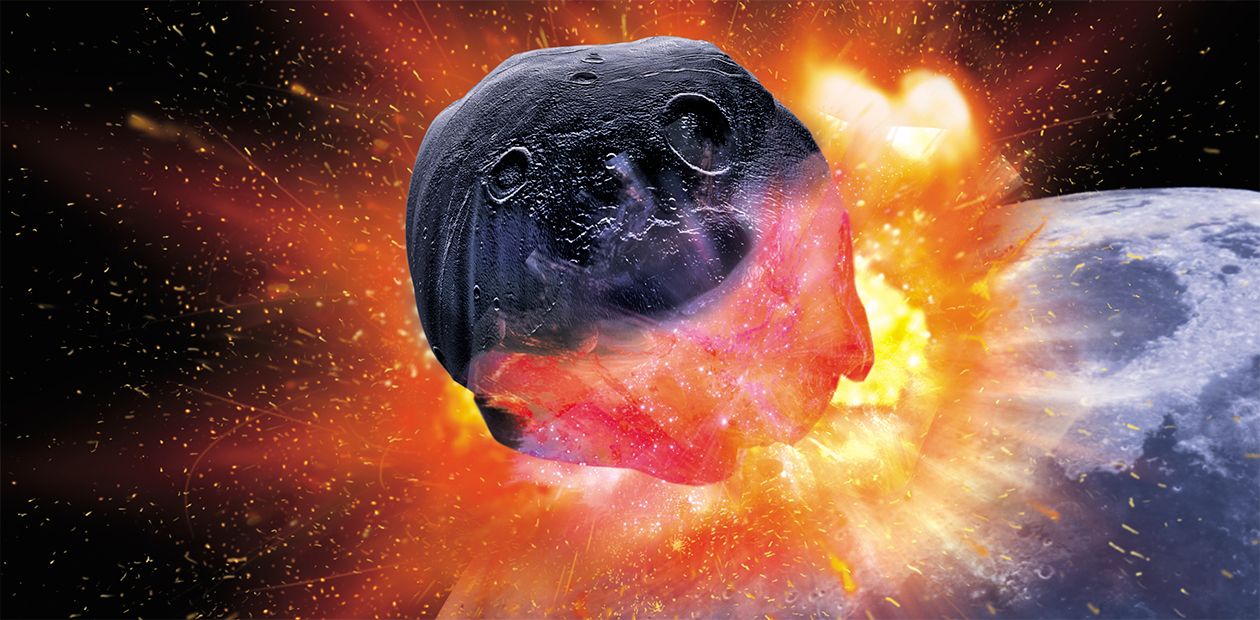Recipes for Creating the World. Geologic Data as the Base for Understanding of the Earth’s Origin
How did our globe form from the protoplanetary disk of dense gas and dust surrounding the young Sun? What processes governed the formation of its iron core? What is the origin of the Moon? The author proposes his own hypotheses and supports them with geologic evidence. He substantiates the existence of the global magma ocean for over four billion years, where elements entering rocks of the Earth were separated. He emphasizes the role of magnetic interactions in the protoplanetary cloud, which may have accelerated the formation of iron-containing planetesimals. Heterogeneous accretion of such metal bodies with the aid of magnetic interaction could form the iron core of our planet much faster than it follows from generally accepted theories of Earth fractionation. The high temperature in the core can be explained by impact heating in the course of metal body collision
The mysterious starry arch has attracted the attention of humans since the earliest times and made them ponder the question: How did celestial bodies and the Earth form? As empirical data were scarce, early answers were mystic and speculative. The development of astronomy supplied more factual evidence, and hypotheses became more substantiated.
There are still many problems concerning the origin of the Earth and planets, but the significant body of presently available information on the geologic structure of the Earth and other celestial bodies provides grounds for fundamental revision of our notions of this subject.
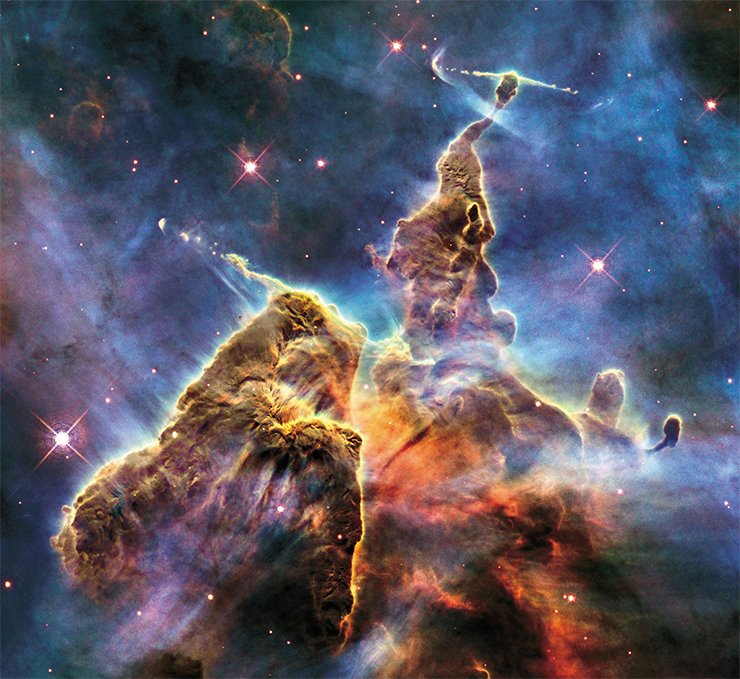
Observations with the Hubble space telescope revealed a number of gas-and-dust nebulae, where stars arose and planets were detected around some of the stars. Therefore, we may state that the nebular hypothesis of Solar System genesis, put forward by Kant and Laplace in the 18th century, is proven to a considerable extent. According to current notions, growing pressure and temperature in the center of such a nebula induced conversion of hydrogen into helium, to further increase its temperature and result in the formation of the Sun. Generally, a gas-and-dust cloud moved rotationally. Particles with the highest rotation velocities less gravitated to the cloud center owing to the centifugal force and remained in the margin. This phenomenon may be related to the disk-like shape of cloud remains and the known paradox that planets have 98% of the angular momentum of the whole Solar System, although they constitute less than 1% of the system mass. The pressure of solar radiation expelled the bulk of gases from the neighborhood of the Sun to the margin of the protoplanetary disk, which is the cause of the high content of gases in outer planets: Jupiter, Saturn, and Uranus.
Cold or hot? Simultaneously or in stages?
There are four hypotheses concerning the accretion of the Earth and other planets, that is, their formation by a fusion of protoplanetary cloud particles: cold, hot, homogeneous, and heterogeneous. According to the first hypothesis, particles forming the Earth were cold (Schmidt, 1962). Their accretion was directed by gravitational forces. It lasted for over one billion years, as thought by O.Yu. Schmidt, or 100 million years according to V.S. Safronov (1969). The accretion was accompanied by the conversion of about 23.2 × 1038 erg of mechanical energy to thermal energy, which was enough to heat the Earth’s matter to 36,000° and evaporate it. However, as believed by the supporters of the cold accretion hypothesis, the long duration of the process allowed the heat to be dissipated to the outer space. Moreover, it is convenient for students of the oldest terrestrial rocks to suppose that the earliest geologic processes did not differ significantly from modern ones (the principle of actualism). For this reason, the cold accretion hypothesis is still widely accepted, notwithstanding that it is based mainly on the calculation of accretion dynamics directed by gravitational forces but neglects the role of magnetic forces, as well as current cosmochemical, isotopic, and geologic evidence.
The observations made by astronauts on the Moon in the second half of the 20th century disagreed with the cold accretion hypothesis, as they unexpectedly revealed signs of the hot formation of the Moon. The Moon lacks chondrites (meteorites that have a composition similar to that of the Earth and containing chondrules, which are round grains composed primarily of silicate minerals). Lunar rocks are of igneous origin, and their isotopic age is as old as 4.4 to 3.7 Ga. They are greatly enriched, with regard to chondrites, in substances accumulated in residual melts during magma crystallization: iron oxides, silica, and rare-earth elements. This fact indicates that the young Moon was covered with a global magma ocean, which then underwent fractionation. A prominent fact is the presence of a 60—100 km thick layer of anorthosites. These rocks, rare on the Earth, are built mainly by the calcium–aluminum silicate plagioclase. The anorthosite layer on the Moon was formed by plagioclase floating in the magma ocean no less than 1000 km deep. Thus, recent data contradict the cold accretion hypothesis for terrestrial planets and point to their hot formation, but the problem is still a subject of controversy.
Another unsolved problem concerns the homogeneous or heterogeneous formation of the Earth and other planets. The homogeneous accretion hypothesis asserts that the composition of the matter forming the planet was time-invariable. Silicate and iron particles fell simultaneously. Then they were separated in the Earth’s bowels by gravitational fractionation and formed the iron core and silicate mantle and crust. According to the heterogeneous accretion hypothesis, the composition of the falling matter changed with time, determining the layered structure of planets. The homogeneous accretion hypothesis is attractive for geologists in that it does not demand any explanation of changes in the falling matter composition. However, we will show below that it disagrees with some theoretical reasoning and cosmochemical and geologic data.
Thus, two important dilemmas remain unsolved: cold or hot formation of the Earth and homogeneous or heterogeneous accretion. Their solution demands invoking geologic evidence.
And yet it is hot!
If the Earth formed hot; was covered by a magma ocean, like the Moon; and the ocean was differentiated by the separation of crystallized minerals, then the largest Earth’s layer, the mantle, should also bear signs of this differentiation. Judging from well-known natural differentiated igneous bodies, these signs include the evolution of the composition of rocks forming during magma cooling and regular time and temperature dependences of their formation. The succession of minerals crystallized in cooling magnesium-rich igneous bodies was as follows: dunites (the highest-temperature rocks, very rich in magnesium), harzburgites (with lesser magnesium contents), lherzolites (with significant amounts of iron), and websterites (enriched in calcium and sodium). Then the melt evolved to the granite composition, rich in silica and alkalis. Under the high-pressure conditions typical for the mantle, the residual melt should change to calcium-rich eclogitic, then to carbonatitic and kimberlitic, which also contain much carbon dioxide. All the listed rocks form mantle rock xenoliths (fragments engulfed by magma) in kimberlites, and it proves the formation of the upper mantle by global magma fractionation.
If mantle rocks were formed by fractionation, their isotopic age should decrease in the succession of their formation. This hypothesis is confirmed by currently available data. The mean isotopic ages are: 2325 Ma for dunites and harzburgites, 1777 Ma for lherzolites, and 713 Ma for websterites. Eclogites, arising from residual melts, have the mean age 1407 Ma; carbonatites, 688 Ma, and kimberlites, 236 Ma. These data agree with the mean ages of inclusions in diamonds, crystallizing during fractionation: 3030 Ma for inclusions of harzburgitic composition, 2777 Ma for peridotitic (poorly defined harzburgitic + lherzolitic), 1966 Ma for lherzolitic, 1123 Ma for eclogitic, and 357 for kimberlitic. The inclusions in diamonds are typically slightly older than the corresponding rocks. This difference can be explained by the protective role of the tough diamond matter, which preserved the oldest minerals from partial dissolution in the most disequilibrated younger residual melt. The Earth age is about 4.65 Ga, and the ages of the oldest inclusions in diamonds are about 3.03 Ga. This difference is due to the fact that the postaccretional magma ocean, forming the upper mantle, was stratified. Therefore, its cooling did not cause extensive convection, and it slowly cooled from top to bottom. As a result, the solidification of the lower layer of the ocean, which formed kimberlitic melts and most of their xenoliths, started relatively late.
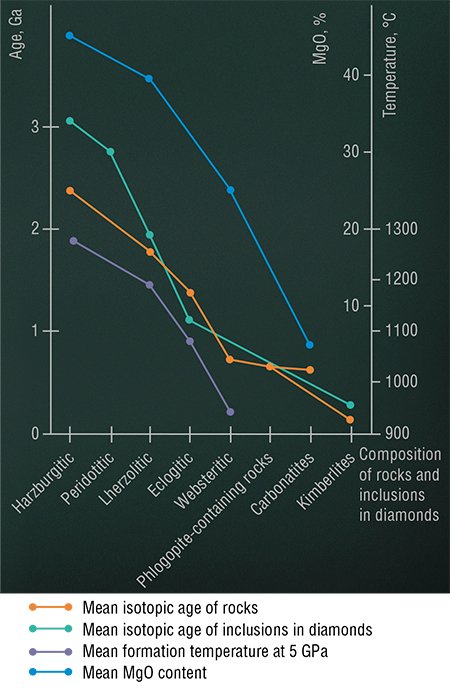 If mantle xenolith rocks in kimberlites were formed by magma fractionation, then the temperatures of formation of their minerals are expected to decrease in the order: harzburgites > eclogites > websterites. At present, the conditions of mantle rock crystallization are assessed by a variety of methods. By summarizing data by various authors we conclude that at 5 GPa, the pressure corresponding to the depth about 150 km, the formation temperatures of the mentioned rocks are 1275, 1190, 1075, and 950°C, respectively. That is, the mean crystallization temperature did decrease from older differentiates to younger in perfect agreement with the succession of their formation during magma fractionation.
If mantle xenolith rocks in kimberlites were formed by magma fractionation, then the temperatures of formation of their minerals are expected to decrease in the order: harzburgites > eclogites > websterites. At present, the conditions of mantle rock crystallization are assessed by a variety of methods. By summarizing data by various authors we conclude that at 5 GPa, the pressure corresponding to the depth about 150 km, the formation temperatures of the mentioned rocks are 1275, 1190, 1075, and 950°C, respectively. That is, the mean crystallization temperature did decrease from older differentiates to younger in perfect agreement with the succession of their formation during magma fractionation.
The content of magnesium oxide in residual melts decreased dramatically with fractionation owing to its subtraction with crystallized minerals. Therefore, its amount is expected to decrease from older differentiates to younger. Indeed, the mean MgO content in harzburgites of the mean age 2325 Ma is 45.0%; in lherzolites (1777 Ma), 39.6%; in websterites (730 Ma), 25.5%; and in carbonatites (65 Ma), 4.0%.
To sum up, geologic data unambiguously point to the formation of cratonic lithosphere (its most rigid and coolest portion, up to 300 km in thickness) by global magma fractionation, occurring throughout the Earth’s history. This conclusion agrees with earlier calculations, which indicate that the fractionation of the postaccretional magma ocean on the Earth lasted for over 4 Ga. The hypothesis of hot formation of the Earth is also confirmed by the signs of cooling of the mantle (ubiquitous replacement of high-temperature minerals by low-temperature ones in kimberlitic xenoliths) and the crust (gradual replacement of plastic deformations by brittle ones). The elevated contents of nitrogen and the light carbon isotope in younger diamonds point to their accumulation in residual melts during deep fractionation. The fact that the crust lacks rocks older than 4 Ga and traces of large-scale meteorite bombardment, completing the accretion, may indicate that subsurface layers of the Earth remained molten for long. In addition, the present-day heat flow from the Earth interior exceeds the putative heat production by radioactive decay five to tenfold, which points to a large reserve of residual heat from planetary accretion.
Signs of heterogeneous accretion of the Earth
The convincing proof of vast tectonic plate movements is the greatest success of geological sciences in the 20th century. Continents were broken and brought apart, oceans appeared and disappeared, mountainous structures and deep depressions arose, volcanoes erupted, and igneous and ore provinces formed. Plate movements were caused by ascending flows of matter, heated by the Earth’s core, in the mantle. It follows from this fact that the core is hotter than the mantle and that there is a temperature gradient between them. The latter has been detected in geophysical studies (Bukowinskii, 1999) and assessed to be within 700—3000 K.
However, the temperature gradient at the core–mantle boundary and the extremely high temperature of the core cannot be explained by the hypothesis of homogeneous accretion of the Earth, predominant in geology. Homogeneous formation of the globe assumes that iron and silicate particles were mixed in the Earth’s interior ab initio; they had equal temperatures and fall simultaneously. Later, the silicate matter was heated by radiogenic heat. Judging from the compositions of meteorites and large iron bodies risen from the core in some basalts, iron has two or three orders of magnitude less radioelements than mantle rocks. Therefore, it could not have been heated, and the temperature in the core could have been even lower than in the mantle. Hence, heat convection could not arise in the latter. With regard to the vague nature of convection and some other phenomena, many scientists outside Russia deny the existence of plumes, and the question “Do mantle plumes exist?” is discussed abroad (Ivanov, 2006). However, the notion of their existence is in such a good agreement with geologic data that the cause of controversy should be sought somewhere else. It is most probable that the homogeneous accretion hypothesis is erroneous.
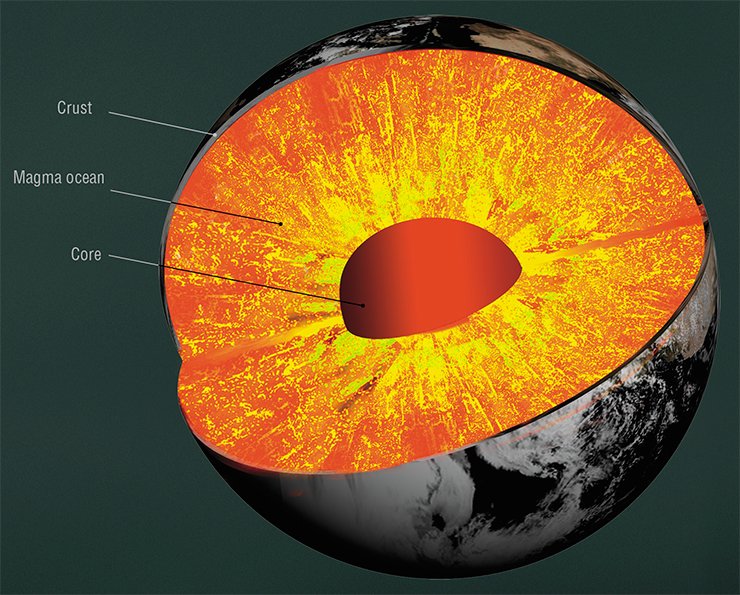
Commonly, this hypothesis is not substantiated by empirical data. In contrast, Harris and Tozer (1967) showed that the rate of aggregation of iron particles magnetized in the magnetic field of the Sun was 20,000 times as high as the rate of their aggregation by the gravitational force. Iron particles were rapidly aggregated by magnetic forces after cooling in the protoplanetary disk below the Curie point (1043 K), when iron could be magnetized. This is proven by very low contents of elements with low condensation temperatures in major types of iron meteorites, which is indicative of the formation of their parental bodies hundreds of kilometers in size at high temperatures of the disk, about 1000 K, i.e., immediately after its reaching the iron Curie point. Then the dissolution of elements condensed in the protoplanetary disk in the iron of meteorites practically stopped, proving that iron particles had been accreted into large bodies. On this reasoning, many scientists conclude that the iron cores of terrestrial planets formed before silicate mantles; thus, the accretion was heterogeneous.
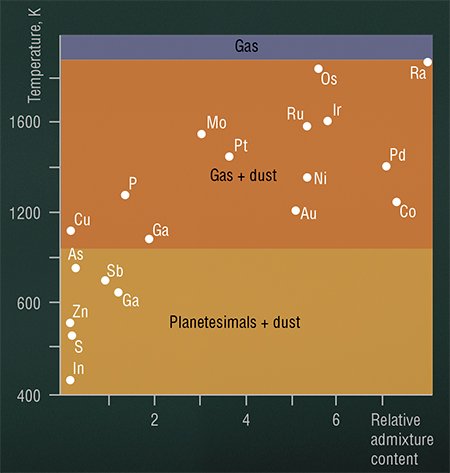 The heat produced by impact energy during core formation from large iron bodies was several orders of magnitude greater than during the subsequent slow accretion of silicate particles centimeters to meters in size and mantle formation, because the proportion of impact heat released during accretion of large bodies that was dissipated with radiation decreased dramatically. This model adequately explains the emergence of the temperature gradient at the core–mantle boundary and heat convection in the mantle.
The heat produced by impact energy during core formation from large iron bodies was several orders of magnitude greater than during the subsequent slow accretion of silicate particles centimeters to meters in size and mantle formation, because the proportion of impact heat released during accretion of large bodies that was dissipated with radiation decreased dramatically. This model adequately explains the emergence of the temperature gradient at the core–mantle boundary and heat convection in the mantle.
To sum up, the Earth was formed by hot heterogeneous accretion. At first, its hot iron core was generated by fast coalescence of iron aggregates in the protoplanetary disk, driven mainly by magnetic forces. Then, silicate particles were attracted by the significant gravitational field. They were molten by impact heat to form the global magma ocean. In the course of accretion, its lower layer crystallized under the influence of the pressure of newly formed upper layers. The precipitated crystals and melts buried in them formed rocks of the lower mantle, cooler than the core. The residual melts enriched the ocean with melt-affine components. Owing to the involvement of magnetic forces, the Earth formed much faster than supposed by Schmidt, and this notion agrees with recent estimates of the duration of its formation: about 10 Ma (Shkodzinskii, 2003). When the accretion ceased, the mean depth of the magma ocean was about 240 km. Its upper silica-rich layer formed the bulk of the rocks of the continental crystalline crust, and the middle and lower layers, rocks of the upper mantle of cratons. Early near-surface residual melts produced ancient granitoids characteristic of cratons, and younger ones, carbonatites and kimberlites.
CHIEF EDITOR’S NOTERapid accumulation of metallic iron owing to magnetic forces is hardly likely. The magnetic field of the Earth appeared with the growth of the liquid iron core and emergence of intense convection in it. It increased after the separation of the inner solid core about 3.3 Ga BP.
Most scientists admit the existence of an about 700 km deep magma ocean in the upper mantle at early stages of Earth formation. However, its long existence determined by the absence of convection seems hardly likely. At present, intense convection exists in the partially molten asthenosphere (1–5% melt at depths within 100–400 km). Judging from isotopic data, the asthenosphere exists for more than 3 Ga. Plate tectonics and mantle plumes ascending from the core–mantle boundary exist at least since the Late Archean, that is, for the last 3 Ga. This fact also argues for the existence of convection in the mantle. Therefore, the calculations pointing that the fractionation of the postaccretional magma ocean on the Earth lasted for more than 4 Ga look unconvincing.
The constant heating of the mantle by the core resulted in the appearance of hot matter flows, strongly tilted west owing to the Coriolis effect. They are responsible for the high modern tectonism and magmatism of the Earth. The very small mass of the lunar core and small reserve of heat in its interior are the result of the cessation of its magmatism about 3.1 Ma BP.
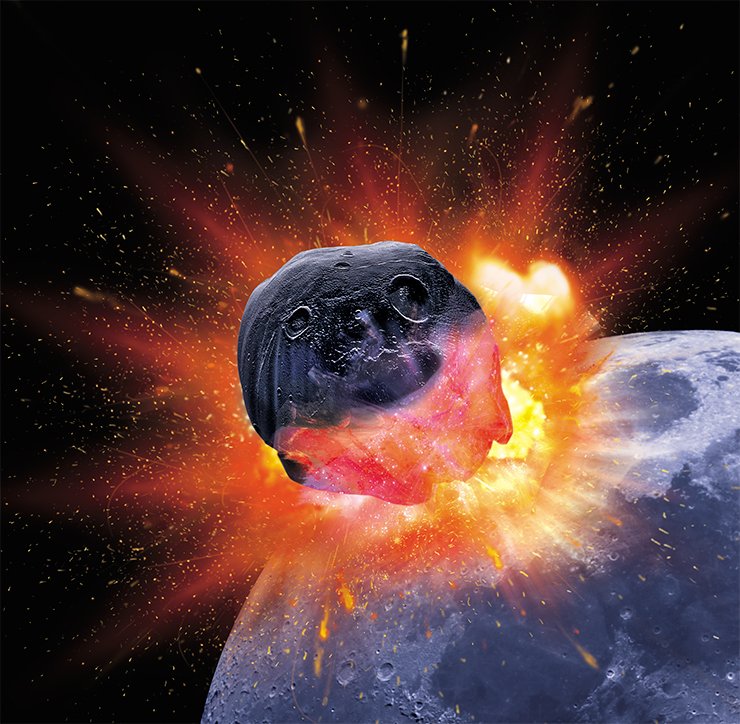
Analysis of geologic data unambiguously indicates that the hypothesis of cold homogeneous formation of the Earth is false. It argues for formation of the globe by hot heterogeneous accretion. Only this model can explain numerous geologic antinomies and enigmata presented by the Earth (Shkodzinskii, 2003). The key advantage of the hot heterogeneous accretion model is that it rests upon geologic and cosmochemical data, which permit one to avoid speculative consideration, typical of earlier hypotheses. Gradual accumulation of facts, not only in astronomy but also in geology, adds to our understanding of the seemingly most mysterious processes of the remote past.
References
Vojtkevich G. V. Proishozhdenie i himicheskaja jevoljucija Zemli. M.: Nauka, 1983. 168 s.
Ivanov A. V. Obojdet li Rossiju «velikij spor o pljumah»? // Geol. i geofiz. 2006. T. 47. № 3. S. 417—420.
Klark S. P., Turek’jan K. K., Grossman L. Model’ rannej istorii Zemli // Priroda tverdoj Zemli. M.: Mir, 1976. S. 9—22.
Safronov V. S. Jevoljucija doplanetnogo oblaka i obrazovanie Zemli i planet. M.: Nauka, 1969. 244 s.
Hain V. E., Halilov Je. N. Ciklichnost’ geodinamicheskih processov: ee vozmozhnaja prichina. M.: Nauchnyj mir, 2009. S. 520.
Shkodzinskii V. S. Priroda razlichnogo soderzhanija azota v almazah // Zapiski RMO. 2011. Ch. SHHHH. № 6. S. 113—118.
Shkodzinskii V. S. Problemy global’noj petrologii. Jakutsk: Sahapoligrafizdat. 2003. 240 s.
Shmidt O. Ju. Proishozhdenie Zemli i planet. M.: Izd. AN SSSR, 1962. 132 s.
Bukowinskii M. S. T. Taking the core temperature // Nature. 1999. Vol. 401. No. 6752. P. 432–433.
Harris P. G., Tozer D. C. Fractionation of iron in the Solar system // Nature. 1967. Vol. 215. No. 5109. P. 1449—1451.
Kelly W. R., Larimer J. W. Chemical fractionations in meteorites. VIII. Iron meteorites and the cosmochemical history of the metal phase // Geochim. et Cosmochim. Acta. 1977. Vol. 41. No. 1. P. 93–112.
Wasch L. J., Van der Zwan F. M., Davies G. et al. Timing and nature of silica enrichment in the Kaapvaal lithosphere mantle // 9th International Kimberlite Conference. Extended Abstract. 2008. No 91RC-A-00121.


